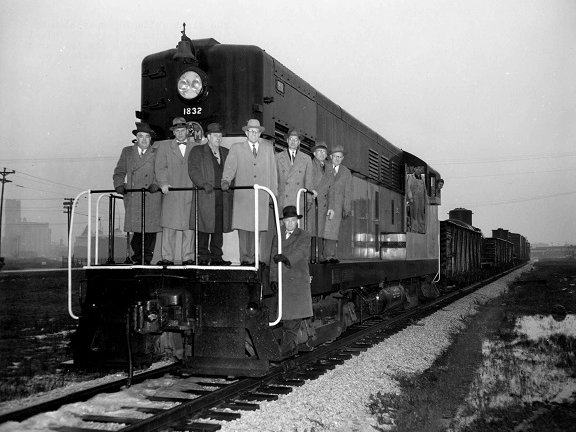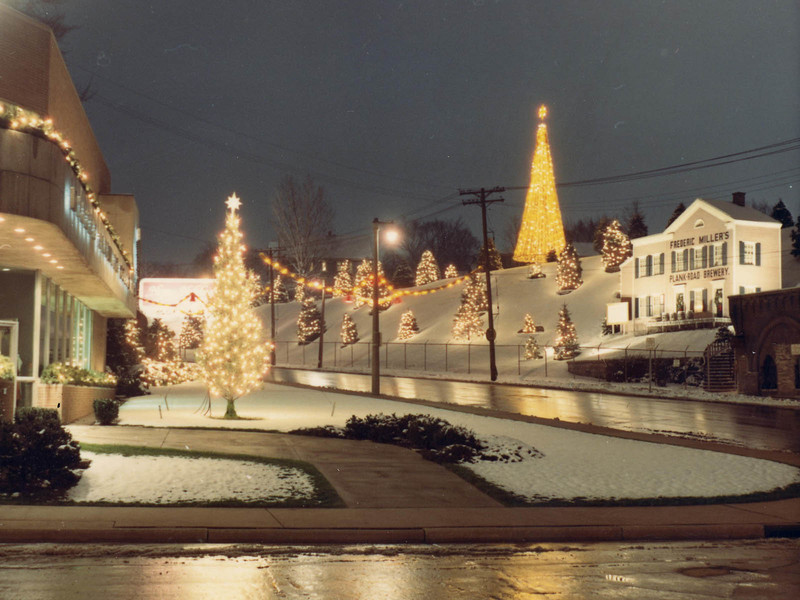Fans of Milwaukee – and Great Lakes – history who haven't signed up for the Wisconsin Marine Historical Society's mailing list are missing out.
The group – headquartered at Milwaukee Public Library, which I featured in this story a few years back – is very active in terms of collecting and archiving documents and photos and objects and also hosts numerous events each year.
The newsletter is an easy way to find a cool old photo in your inbox every week (sometimes more). And, because these folks are history buffs like the rest of us, there's always a story behind the photo and the WMHS folks share that story.
I especially enjoyed this one because I once got the chance to tour one of the vessels mentioned: the Ostrander. You can read that story here. Here is today's story from the Wisconsin Marine Historical Society:
On this Feb. 5, 1953, a Milwaukee Road locomotive pulled a short train across Chicago & Northwestern tracks and onto Jones Island. For the city of Milwaukee, this concluded a 26-year struggle "to open the harbor to all shippers and carriers on equal terms."
Previously, shippers served by the Milwaukee Road had been at a disadvantage because of switching rates and service. But before the city could open its harbor, there would be an old-time railroad fight that newspapers dubbed the "Battle of Jones Island."
Jones Island is actually a mile-long peninsula extending south from the harbor entrance, and bordered by Lake Michigan and the Kinnickinnic River. Early on, the southern part of this peninsula was occupied by a sprawling steel mill, which started in 1868 as the Milwaukee Iron Company. Illinois Steel acquired the facility, and would later join other steel makers to form United States Steel in 1901.
In the early 20th century, Milwaukee was largely served by two railroads: Chicago, Milwaukee, St. Paul & Pacific (Milwaukee Road); and Chicago & North Western (North Western). Both served Illinois Steel. North Western’s mainline ran along the property’s western edge, so it had easy access. The Milwaukee Road reached the mill using its Bay View spur, which crossed the North Western tracks at grade. An interlocking tower protected the crossing.
At this time, there was no industrial development on Jones Island except for the steel mill. On the northern tip Milwaukee would build a modern wastewater treatment plant, which began operating in 1925.
Illinois Steel had an extensive network of tracks and operated its own railroad. All rail shipments to or from Jones Island were delivered to or retrieved from a sidetrack at the steel company. Illinois Steel used its own power to move cars within its facility and service the wastewater plant. This arrangement worked well until the mill closed.
Milwaukee leaders wanted land on Jones Island to expand port facilities. In 1926, the city acquired 51 acres from Illinois Steel for the purpose of improving rail connections. Dredging and filling for a municipal carferry terminal adjacent to the sewage treatment plant began the next year. For ferry operators, this new terminal would be much closer to the harbor entrance and would avoid moveable bridges.
In 1928, the city entered an agreement with the North Western giving the railroad access to city-owned tracks being laid on Jones Island. This agreement reflected the city’s policy that the harbor terminal shall be open to all railways on equal terms. It included a provision making it clear that the city was free to make similar agreements with other railroads.
Illinois Steel discontinued operations at the Milwaukee mill in 1928. Milwaukee Road’s Bay View spur now connected with a sidetrack controlled by the North Western instead of the steel company. When the North Western refused permission to use the existing crossover and sidetrack, the Milwaukee Road lost access to Jones Island.
Milwaukee’s first two harbor development projects on Jones Island, an open dock and the carferry terminal, were completed in 1929. At the terminal’s inauguration, Fred W. Sargent, president of the North Western, told guests: "Milwaukee has the finest natural harbor on the great lakes and the North Western road is pleased to cooperate with the city to the fullest extent in developing Milwaukee as a rail and water transportation center."
That would not be the case. The North Western would do everything possible to keep the Milwaukee Road off Jones Island. This was a problem as the city worked to promote its new terminal. It was reported in 1931 that the Ann Arbor Railroad refused to come into Milwaukee because the harbor commission could not give it a connection with the Milwaukee Road. Likewise, the Pennsylvania Railroad was hesitant because it would have to pay an extra half-cent a hundredweight switching charge on any car consigned to a plant served by the Milwaukee Road.
"Numerous conferences" between representatives from the city and railroad officials failed to resolve the matter of rail access. The city bought the Illinois Steel property in 1938. More than ever, city leaders wanted Jones Island opened to all railroads.
In 1944, Milwaukee’s Common Council adopted a resolution authorizing and instructing the City Attorney to petition the Wisconsin Public Service Commission for an order directing that the Bay View spur be connected with city-owned tracks on Jones Island. It was now time for the North Western to unleash its lawyers.
It took three opinions and assistance from the Dane County Circuit Court, but the Public Service Commission ultimately concluded it had no jurisdiction. The proper forum was the Interstate Commerce Commission (ICC). So in 1949, the Common Council adopted a resolution instructing the City Attorney to petition the ICC.
In October 1950, a panel of three commissioners found the connection was: required by public convenience and necessity; practicable and safe; and justified by sufficient business. Upon reconsideration, the Commission confirmed the panel’s conclusions and ordered that an extension "be completed and in operation before February 11, 1952."
North Western’s lawyers now appealed to the federal courts. The District Court for the Northern District of Illinois dismissed their complaint. On direct appeal, the Supreme Court affirmed the ICC decision in November 1952 and denied a motion for rehearing on Dec. 8. So the Jones Island monopoly was finally broken.
Yogi Berra, baseball player and philosopher, once said: "It ain’t over till it’s over." The city and Milwaukee Road announced on Thursday, Dec. 18, that construction of the crossover and extension ordered by the ICC would begin the following day. Armed with picks and shovels, a track gang arrived Friday morning. They found a string of 30 empty boxcars, one of which had been derailed, occupying the sidetrack. Also at the scene were North Western’s railroad police. It appeared the North Western was not going to surrender its monopoly without a fight.
Milwaukee Road’s president ordered his men to move the boxcars. Claiming a North Western official said the railroad would use "physical force" to prevent a crossing of its right of way, Milwaukee’s mayor dispatched the city’s police. But cooler heads prevailed and the "Battle of Jones Island" fizzled.
An agreement between the two railroads brought a peaceful but temporary solution. The Milwaukee Road would be allowed to build the crossover and extension, but it could not use it for three weeks. This gave the North Western time to ask the ICC to reopen the case. It would also take at least that long to complete construction and install necessary safety equipment.
Ultimately, the ICC did not reopen the case and work on the Bay View spur extension was completed. Feb. 5, 1953, the first Milwaukee Road train made its way across North Western tracks and onto Jones Island. City and railroad officials climbed aboard the Fairbanks-Morse H12-44 switcher and posed for pictures. Mayor Frank Zeidler had earlier proclaimed this would mark "a new phase of harbor development and of service by the harbor to a much wider area."
That August, a Milwaukee Road vice president wrote to Mayor Zeidler. He recalled the long legal battle before his railroad was allowed access to Jones Island. Then he noted that in the six months since service started, the city Sewerage Commission had shipped only 77 cars via the Milwaukee Road. According to the executive, "it would appear that we are enjoying a rather empty legal victory if we cannot participate to a greater extent in the traffic that is moving."
Today the carferry terminal is gone and trucks move much of the cargo on Jones Island. But two railroads still serve boats that call at Milwaukee. Union Pacific accesses Jones Island using the former North Western right of way. Canadian Pacific does so on the old Milwaukee Road tracks.
NOTES:
Jones Island has been the scene of several confrontations. There was the Rolling Mills Massacre; a lengthy court battle over land ownership; the fight for rail access; efforts by Bay View residents to limit fuel storage tanks on the island.
Exactly when Illinois Steel ceased operations at its aging and undersized Milwaukee mill is unclear. According to ICC documents, it was 1928.
Cars for the Milwaukee Road going through Jones Island were interchanged at a yard four miles west of the harbor. This required movement through a congested rail corridor often resulting in delays.
Pere Marquette and Grand Trunk railroads both maintained private ferry slips along the Kinnickinnic River after Milwaukee opened its municipal terminal. Pere Marquette did move some operations to Jones Island in 1930. It moved all operations there in 1960. Grand Trunk joined them at the municipal terminal in 1974. The last ferry departed from Jones Island in 1984.
In 1950 the city owned about 10 miles of track on Jones Island. Because of the layout, only one switch crew could work there at any given time.
Born in Brooklyn, N.Y., where he lived until he was 17, Bobby received his BA-Mass Communications from UWM in 1989 and has lived in Walker's Point, Bay View, Enderis Park, South Milwaukee and on the East Side.
He has published three non-fiction books in Italy – including one about an event in Milwaukee history, which was published in the U.S. in autumn 2010. Four more books, all about Milwaukee, have been published by The History Press.
With his most recent band, The Yell Leaders, Bobby released four LPs and had a songs featured in episodes of TV's "Party of Five" and "Dawson's Creek," and films in Japan, South America and the U.S. The Yell Leaders were named the best unsigned band in their region by VH-1 as part of its Rock Across America 1998 Tour. Most recently, the band contributed tracks to a UK vinyl/CD tribute to the Redskins and collaborated on a track with Italian novelist Enrico Remmert.
He's produced three installments of the "OMCD" series of local music compilations for OnMilwaukee.com and in 2007 produced a CD of Italian music and poetry.
In 2005, he was awarded the City of Asti's (Italy) Journalism Prize for his work focusing on that area. He has also won awards from the Milwaukee Press Club.
He has be heard on 88Nine Radio Milwaukee talking about his "Urban Spelunking" series of stories, in that station's most popular podcast.







